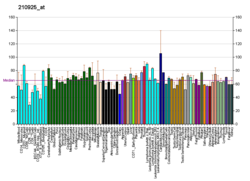CIITA is a human gene which encodes a protein called the class II, major histocompatibility complex, transactivator.[5] Mutations in this gene are responsible for the bare lymphocyte syndrome in which the immune system is severely compromised and cannot effectively fight infection.[5] Chromosomal rearrangement of CIITA is involved in the pathogenesis of Hodgkin lymphoma and primary mediastinal B cell lymphoma.[6]
Function
CIITA mRNA can only be detected in human leukocyte antigen (HLA) system class II-positive cell lines and tissues. This highly restricted tissue distribution suggests that expression of HLA class II genes is to a large extent under the control of CIITA.[7] However, CIITA does not appear to directly bind to DNA.[7] Instead CIITA functions through activation of the transcription factor RFX5.[8] Hence CIITA is classified as a transcriptional coactivator.
The CIITA protein contains an acidic transcriptional activation domain, 4 LRRs (leucine-rich repeats) and a GTP binding domain.[9] The protein uses GTP binding to facilitate its own transport into the nucleus.[10] Once in the nucleus, the protein acts as a positive regulator of class II major histocompatibility complex gene transcription, and is often referred to as the "master control factor" for the expression of these genes.[11][12]
CIITA expression is induced by interferon gamma, possibly assisted by other signals.[13] MHC II expression in intestinal epithelial cells is upregulated under inflammation.[13]
Interactions
CIITA has been shown to interact with:
See also
References
External links
- MHC+class+II+transactivator+protein at the U.S. National Library of Medicine Medical Subject Headings (MeSH)
- Human CIITA genome location and CIITA gene details page in the UCSC Genome Browser.
This article incorporates text from the United States National Library of Medicine, which is in the public domain.





